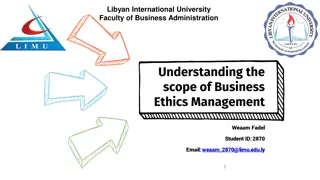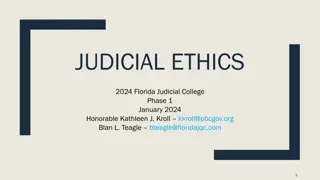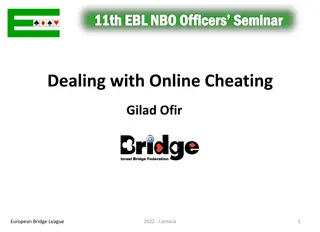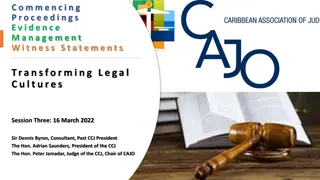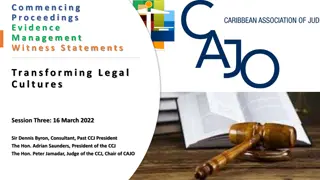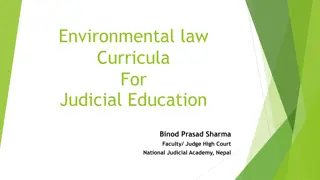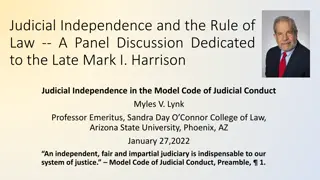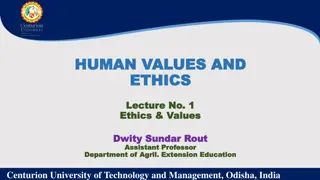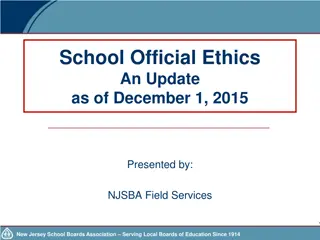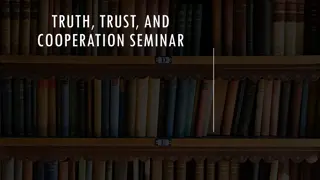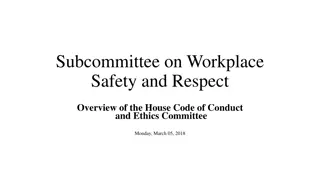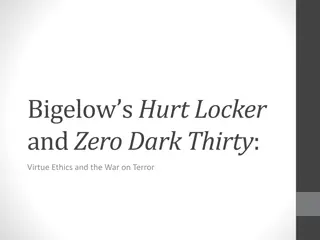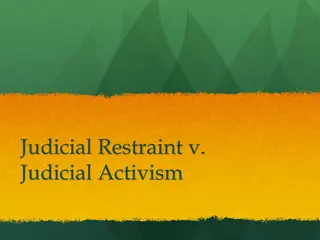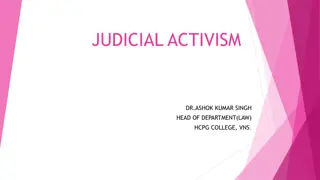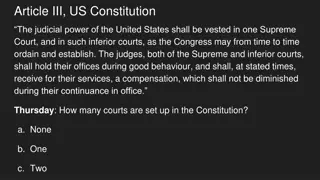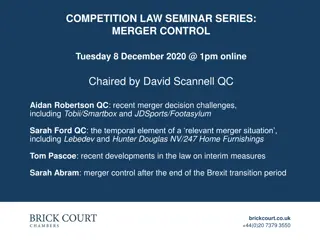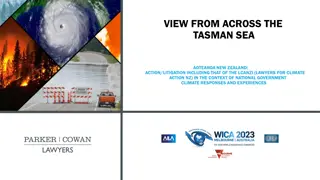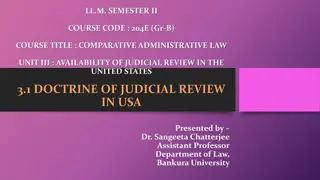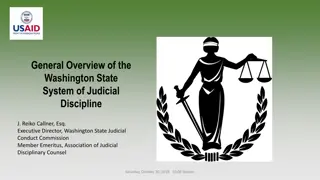Legal Education and Judicial Ethics Seminar - Transforming Legal Cultures
Enhance your understanding of the CPR overriding objective and its interpretative mandates in the legal context. Explore concepts of substantive and procedural justice, principles of proportionality, and the judicial oath of office. Delve into the Supreme Law of the Bahamas, right to protection of the law, fair hearing principles, and the Bangalore Principles of Judicial Conduct. Discover the importance of competence, diligence, and efficiency in judicial functions.
Download Presentation

Please find below an Image/Link to download the presentation.
The content on the website is provided AS IS for your information and personal use only. It may not be sold, licensed, or shared on other websites without obtaining consent from the author. Download presentation by click this link. If you encounter any issues during the download, it is possible that the publisher has removed the file from their server.
E N D
Presentation Transcript
Bahamas CPR Training 2002 Overriding Objective Pre-action Protocols ADR Issue Identification and Treatment Transforming Legal Cultures Session Two: 2nd March 2022 Session Two: 2nd March 2022 Sir Dennis Byron, Consultant, Past CCJ President Sir Dennis Byron, Consultant, Past CCJ President Hon Adrian Saunders, President of the CCJ Hon Adrian Saunders, President of the CCJ Hon Peter Jamadar, Judge of the CCJ and Chair of CAJO Hon Peter Jamadar, Judge of the CCJ and Chair of CAJO
The Overriding Objective Getting to the Heart of the Matter Part 1 CPR, 2002
At the end of this session participants will: Become aware of and knowledgeable about the (i) interpretative and (ii) executory mandates of the CPR overriding objective in the context of: (a)Substantive and procedural justice; (b)Dealing justly with cases; (c)Principles of proportionality; equal footing; expedition; fairness; saving expense; enforcing compliance; and appropriate use of court resources.
Our Judicial Oath of Office: Who & What We Are I, .................................................. do swear that I will well and truly serve Her Majesty Queen Elizabeth the Second, Her Heirs and Successors, in the office of ................................... and will do right to all manner of people after the laws and usages of The Bahamas without fear or favour, affection or ill will. So help me God. Official Oaths Act, Ch 31 1, Section 5, First Schedule (4), Laws of Bahamas
Constitution S 2 The Constitution is the Supreme Law S 15 (a) The Right to Protection of the Law S 20 The Right to be afforded a Fair Hearing within a Reasonable Time (though specifically directed to criminal matters in s 20 the fair hearing principle is a general constitutional standard covered by the core preambular value of the rule of law and protection of the law) Bangalore Principles of Judicial Conduct Competence and Diligence includes preparation, expedition, and efficiency in the performance of judicial functions including the delivery of reserved judgments Establishing Some Overarching Context - 1
Establishing Some Overarching Context - 2 Competence: acting on the latest legal developments and performing duties and responsibilities relevant to the judicial function and the court s operations with excellence, including the just and fair management of cases, litigants, attorneys, Judiciary staff and the public. Efficiency: managing cases in a timely and expeditious fashion and within established performance standards; maximizing the economic use of available court resources. Effectiveness: managing cases in ways that are proportionate to the matters in issue and time and resources devoted to the case; making decisions that are clear, coherent and enforceable and that further the objectives of the CPR, including the overriding objective of dealing with cases justly; making decisions that reflect the fact that the Administration of Justice involves real people involved in real-life situations. Impartiality/Fairness: At all times and at all stages matters must be conducted fairly and impartially, in relation to all court users - parties, witnesses, and attorneys.
Part 1 The Overriding Objective CPR 1.1 1.1 The Overriding Objective (1) The overriding objective of these Rules is to enable the court to deal with cases justly and at proportionate cost. (2) Dealing justly with a case includes, so far as is practicable: (a) ensuring that the parties are on an equal footing; (b) saving expense; (c) dealing with the case in ways which are proportionate to (i) the amount of money involved; (ii) the importance of the case; (iii) the complexity of the issues; and (iv) the financial position of each party; (d) ensuring that it is dealt with expeditiously and fairly; (e) allotting to it an appropriate share of the court s resources, while taking into account the need to allot resources to other cases; and (f) enforcing compliance with rules, practice directions and orders.
Part 1 The Overriding Objective CPR 1.2 1.2 Application of overriding objective by the court (1) The court must seek to give effect to the overriding objective when (a) exercising any powers under these Rules; (b) exercising any discretion given to it by the Rules; or (c) interpreting these Rules. (2) These Rules shall be liberally construed to give effect to the overriding objective and, in particular, to secure the just, most expeditious and least expensive determination of every cause or matter on its merits. CPR 1.3 1.3 Duty of parties It is the duty of the parties to help the court to further the overriding objective. In applying the Rules to give effect to the overriding objective the Court may take into account a party s failure to help in this respect. [Part 25 deals with the court s duty to forward the overriding objective by active case management.]
The (i) Interpretative and (ii) Executory mandates of the CPR Overriding Objective 1.2 Application of overriding objective by the court (1) The court must seek to give effect to the overriding objective when (a) exercising any powers under these Rules; (b) exercising any discretion given to it by the Rules; or (c) interpreting these Rules. (2) These Rules shall be liberally construed to give effect to the overriding objective and, in particular, to secure the just, most expeditious and least expensive determination of every cause or matter on its merits. JUST DETERMINATION: INTERPRETATION; APPLICATION - to secure - EXPEDITION; MINIMAL COSTS
Dealing justly with cases: CPR 1.1 1.1 The Overriding Objective (1) The overriding objective of these Rules is to enable the court to deal with cases justly and at proportionate cost. Dealing justly with a case is not limited to the explicit statement as to what that includes, as set out in CPR 1.1(2). Dealing justly with a case is ultimately a matter of judicial discretion and can be one of the most challenging tasks that the CPR Judge has to perform.
Principles of proportionality; equal footing; expedition; fairness; saving expense; enforcing compliance; and appropriate use of court resources CPR 1.1 1.1 The Overriding Objective (2) Dealing justly with a case includes, so far as is practicable: (a) ensuring that the parties are on an equal footing; (b) saving expense; (c) dealing with the case in ways which are proportionate to (i) the amount of money involved; (ii) the importance of the case; (iii) the complexity of the issues; and (iv) the financial position of each party; (d) ensuring that it is dealt with expeditiously and fairly; (e) allotting to it an appropriate share of the court s resources, while taking into account the need to allot resources to other cases; and (f) enforcing compliance with rules, practice directions and orders.
7 Key Principles CPR 1.1 1.1 The Overriding Objective (2) Dealing justly with a case includes, so far as is practicable: 7 Key Principles: - proportionality; - equal footing; - expedition; - fairness; - saving expense; - enforcing compliance; and - appropriate use of court resources
Substantive and Procedural Justice The function of SUBSTANTIVE LAW is to define, create or confer substantive legal rights or legal status or to impose and define the nature and extent of legal duties. On the other hand, rules of court are a source of PROCEDURAL LAW the function of which is to prescribe and regulate the machinery or manner in which legal rights or status and legal duties may be enforced or recognized by a court of law. The two branches are complementary and interdependent, and the interplay between them often conceals what is substantive and what is procedural. It is by procedure that the law is put into motion, and it is procedural law which puts life into the substantive law, gives it its effectiveness and brings it into being. Rules of court, therefore, are of fundamental importance to the good administration of justice
Substantive and Procedural Justice under the CPR it is no longer right to say that the court s function is to do substantive justice on the merits and no more. The overriding objective adds the imperatives of deciding cases expeditiously and using no more than proportionate resources. - Charmaine Bernard v Ramesh Seebalack [2010] UKPC 15 [23]
Substantive and Procedural Justice The Court of Appeal of Trinidad and Tobago has unanimously observed that: Under the CPR, justice, therefore, is not distinct or superior to the overriding objective. Doing justice under the CPR is to enable a case to be dealt with justly in accordance with the overriding objective . - Charmaine Bernard v Ramesh Seebalack With the CPR, there is only just dealing, and this happens when there is the fair and just application of both the procedural and substantive law, culminating in just disposition.
The New Role of the CPR Judge: A fundamental ideological shift from a lawyer-driven court to a Judge- controlled court . The Court of Appeal of Trinidad and Tobago has also observed that: [30] While it is accepted that in adversarial litigation judges must be cautious to always preserve the core judicial values of independence and impartiality, it is equally clear that the role of the judge under the Civil Proceedings Rules, 1998 is significantly different from what previously obtained. This is apparent from the overriding objective and the provisions of the CPR itself... [32] The CPR, 1998 have brought about a seismic shift in the roles, responsibilities and powers of the court to manage and shape litigation, and to control its unfolding in terms of issues and timing. - Her Worship Magistrate Marcia Ayers-Caesar and Another v BS, TT Civ App No 252 of 2015, [31]
Duty of Attorneys and Parties: To Render Assistance in Furthering the Overriding Objective CPR 1.3 1.3 Duty of parties It is the duty of the parties to help the court to further the overriding objective. In applying the Rules to give effect to the overriding objective the Court may take into account a party s failure to help in this respect. A Segue into Case Management and Related Areas Pre-Action Protocols & ADR [Part 25 deals with the court s duty to forward the overriding objective by active case management.]
Pre-Action Protocols and ADR Bahamas Possibilities and Potential
At the end of this session participants will: Become aware and knowledgeable about the utility and value of pre-action protocols and ADR, and in particular: (a) Be exposed to discrete measures/tools that animate the overriding objective and the transformational culture infused in the rules by promoting and facilitating settlements; (b) Be able to describe the enabling framework required for implementation of these measures; (c) Be able to demonstrate why adoption of these measures is critical (d) Be aware of the impact of the forgoing on the overriding objective on the Overriding Objective
Introduced in Trinidad and Tobago by a Practice Direction. The concept of PPs is to enable parties to seek information from and to provide information to each other about a prospective legal claim. The objectives are threefold: a) To encourage the exchange of early and full information about the prospective claim; b) To enable parties to avoid litigation by possible settlement; c) To support the efficient management of proceedings. Pre-Action Protocols (PP)
Compliance with PPs is obviously not required in urgent matters or where a period of limitation is about to expire. Where however, compliance should be the norm and if not adhered to should be taken into account when the court decides to exercise a power under Part 26 (General Powers of the Court) or under Part 71 (Costs). not urgent, Parties reasonably exchanging documents and in trying to avoid litigation. are expected and information to act in and promptly Pre-Action Protocols
Pre-Action Protocols Contents of the Claimant s PP letter i) Concise details of the Claim; ii) Enclose copies of essential document relied on ; iii) Ask for prompt acknowledgment of the letter; iv) Identify and ask for copies of any essential documents the defendant may have; v) Advert to possibility of mediation vi) Draw attention to the court s powers to impose sanctions for failure to comply with the practice direction
Pre-Action Protocols Defendant s Response to the claimant s PP letter The Defendant may: Accept the claim in whole or in part and make proposals for settlement, or a) b) State that the claim is not accepted If the claim is not accepted, the response should: a) Give detailed reasons why it is not accepted, b) identifying which of the claimant s contentions are in dispute. c) Enclose copies of documents asked for by the claimant or explain why they are not enclosed. d) Identify and ask for copies of any further documents which the defendant wishes to see. e) State whether the defendant is prepared to enter into mediation.
Forms/ Templates The TnT Practice Direction sets out PP Templates for a claimant s pre-action protocol letter for and the defendant s response to claims in relation to: i. a specified sum of money i. road traffic accident and personal injury claim i. Defamation i. an administrative order under your Part 54 i.e. judicial review
Alternative Dispute Resolution (ADR) WHY ADR Some cases are better resolved via some form of ADR; Some litigants merely want to be heard
The Authority for ADR The legislative authority for appropriate dispute resolution is grounded in Part 25.1(i). The rule states that the court must further the overriding objective by, among other things: encouraging the parties to use any appropriate form of ADR procedure including, in particular, mediation, if the court considers it appropriate; and facilitating the use of such procedures.
Some disputes are tailor made for arbitration Where the subject matter involves great technical factual disputes e.g. complex building contracts
Arbitration Encouraging referral to arbitration in no way undermines the judicial function. If anything it shows a measure of sophistication in your management skills that a judge should have the perspicacity and confidence to refer all or part of a matter to arbitration.
Arbitration Referral to arbitration with the agreement of the parties can: lighten court dockets; address knotty factual issues that call for specialised knowledge.
Some disputes are tailor made for mediation Landlord/Tenant disputes Motor vehicle claims especially where there is no counterclaim Some breaches of contract.
Alternative Dispute Resolution (ADR) Difference between satisfying interests and determining rights
Mediation There is a need for training among both Bench and Bar. - How does a mediator s role differ from a judge s role in encouraging a settlement? What is counsel s role in a mediation? Under what circumstances should a judge refer or not refer a matter to mediation? What are the benefits of mediation?
The Mediation Settlement Rate The ECSC has had excellent results with mediation. It is particularly robust in Grenada and Saint Lucia. The international settlement rate of matters referred to mediation is approximately 40% - 50%. In the ECSC in the first year or so we had a settlement rate of close to 70% because at the outset we cherry picked what to refer. Later, as we became more aggressive the settlement rate fell to about 50%.
Early Neutral Evaluation What is it? ENV does not depend upon but is aided by a docket system. This means that a case is assigned to a judge from the time it is filed and it remains with that judge until it is finally disposed of. ENV allows the assigned judge to assess when after a Defence has been filed, a case is ripe for ENV. If the assigned judge makes that determination, they can then send th e case to another judge who can frankly and fully discuss with the parties the chances of success of the claim and or the defence. The ENV judge is not constrained because they will not be hearing the case.
Early Neutral Evaluation ENV is specifically referenced in the Rules at Part 26.1(1)(v) where the court is empowered to take any other step, give any other direction, or make any other order for the purpose of managing the case and furthering the overriding objective, including hearing an Early Neutral Evaluation, or directing that such a hearing take place before a court appointed neutral third party, with the aim of helping the parties settle the case.
Why the emphasis on Settlements?
Narrowing the issues for Bahamas CPR training Bahamas A Key that Unlocks the CPR
At the end of this session participants will: Become importance of early identification, analysis, and treatment (prioritization) of issues, and in particular: aware and knowledgeable about the critical (a) Understand the importance of narrowing the issues to be resolved. (b) Be exposed to techniques for narrowing the issues. (c) Be aware of the impact of narrowing issues on the Overriding Objective.
Narrowing the Issues, a Team Sport Narrowing the Issues, a Team Sport to improve justice delivery to improve justice delivery Access to justice is threatened: more cases without proportionate increase of judges; Substantial backlogs and delays; Increased cost of legal services; Imbalance in resources of litigants with vulnerability to endless procedural skirmishesand technicalities; reduced public confidence in judicial system Overriding Objective introduces Cultural Change to improve quality of justice remembering that objective justice involves pursuit of truth Culture of lawyers must change; reduce emphasis on the traditional adversarial system; no longer be just the mouthpiece of clients; exercise active duty to pursue just resolution of disputes. Duty to court and justice takes precedence over duty to clients. Must minimize use of court resources; narrow issues with duties of disclosure; not abuse the process of the courts; comply with rules and orders of the court and conduct cases efficiently and expeditiously; confer with other side to reach settlement, or narrow issues for trial. Culture of the judges must change too; Must be more proactive; encourage settlements and conferring between parties; actively manage and take responsibility for the timely and fair disposition of cases; identify and narrow issues for determination; confine trials, where necessary, to real issues of significance
Narrowing the Issues Creating a New Court Culture Narrowing the issues to be resolved will expedite fair disposition of cases and save expense.
Narrowing the Issues CPR 1.1(1) The overriding objective of these Rules is to enable the court to deal with cases justly and at proportionate cost. [NOTE: CPR 1.1(2)] CPR 1.3 It is the duty of the parties to help the court further the overriding objective. CPR 25.1 The court must further the overriding objective by actively managing cases. This may include: (a) identifying the issues at an early stage
All issues that are irrelevant to the resolution of the main issue in dispute are eliminated. The issues are narrowed when: Parties are not required to prove facts on which they agree. There is agreement on all or some of the legal principles relevant to the adjudication of the dispute. When an issue which could determine the outcome of the case is resolved. Can you add something more?
Identification and Narrowing of Issues and Narrowing of Issues New exercise Issues can be identified and narrowed at various stages of proceedings: e.g. after filing of defence: or after discovery of documents or filing of witness statements Issues cannot be easily identified and narrowed if the applicable legal standards are unclear: imposes duty on the formulation of claims and defences. Issues cannot be easily identified and narrowed if uncertainty about facts causes generalized rather than specific pleadings. Appropriate protocols before action could assist in reducing incidence of this. Issue identification is crucial to discovery: Standard Disclosure CPR 28.4 must disclose documents which are directly relevant to the matters in question in the proceedings Specific Disclosure CPR 28.5 (5) an order may require disclosure only of documents which are directly relevant to one or more matters in issue in the proceedings: CPR 28.6(1) Court must consider whether specific disclosure is necessary in order to dispose fairly of the claim or save costs. Issue identification assists court in applying the principle that evidence must be relevant facilitating the making of orders to admit or exclude
Early Identification of Issues Identification of Issues Issues define legal and factual contentions of parties and focus the court on the areas of dispute and indicate the areas of agreement. Clearly defined issues guide the court in ruling on ancillary questions such as scope of discovery. By clarifying areas of agreement and disagreement the parties may be better able to assess their positions and promote rapid settlement and adjudication. Issues must be defined before they can be narrowed or refined. Uncertainty of the facts and applicable law are prime sources of difficulty in defining issues. A limited knowledge of the facts may contribute to poorly defined issues at the commencement of an action.
Duty to narrow issues in pleadings CPR 1.3 court may take into account parties failure to help in applying the overriding objective. CPR 71.5(3) and (4) in deciding costs order court may take conduct of party into account CPR 8.7:CPR 10.5: CPR 28.4 Parties must clarify and narrow issues in their pleadings by stating, admitting or denying relevant facts, and identifying or annexing necessary supporting documents. CPR 26.2(1):Court has power to strike out pleadings that are prolixity and irrelevant on own initiative or CPR 26.3(1)which do not have value in developing the case CPR 28.4: Parties have duty to make standard disclosure CPR 28.5 and.6 Court has power to compel specific disclosure .: CPR
Techniques of Narrowing the Issues Techniques of Narrowing the Issues The Court may Require lawyers to narrow issues by filing at CMC Agreed statements on facts and law not in dispute Agreed statements on matters which might otherwise require interlocutory proceedings Agreed statements of opposing experts witness to confer to narrow issues in dispute Agreed statements on issues remaining for trial if any Prioritize and dispose of issue which could resolve liability of whole or part of matter Enter judgment on whole or part of claim If statement of case for claimant or defendant fails to state a claim or defence for whole or part of claim If no material facts need to be resolved for whole or part of claim: base judgment as a matter of law; without or without oral hearing If evidence is excluded leaving party unable to prove essential fact e.g. Negligence case: court can evidence of damages if claimant did not introduce evidence of foreseeability or causation If matter has to go to trial limit: number of witnesses to be called issues for cross examination points of law to address
Court can order parties (inter alia) to file agreed statements, or separate statements if agreement cannot be reached before 1stCMC to facilitate orders narrowing issues (4)Parties to file agreed Statement of (narrowed) issues or separate statements if agreement not reached: (1) Parties to file agreed statement of admissions or separate statements if no agreement reached (5) Parties to file agreed notice of any issue(s) which if determined could resolve the whole or substantial part of dispute, or separate notices if no agreement reached (2) Parties to file agreed statement showing facts agreed and those remaining in issue , if any, or separate statements if no agreement reached (3) Parties to file agreed statement of legal principles on which trial is conducted or separate statements if agreement not reached. (6) In appropriate case: Parties to file submissions on whether judgment can be entered on the pleadings, to be adjudicated with or without oral hearing, as the case may be
Mechanisms 1stCMC must take place not more than 12 weeks after defence. (CPR 27.3(3)) Defence must be filed not later than 56 days after service - see excel sheet Court must pay attention to timetabling Judicial pleadings and evidentiary material on the record preparation by analysis of Send checklist to require specified filings and before CMC.
Can the issue of liability be isolated and resolved as a discreet issue? What is the impact of this on the time to disposition? The Fish Farm Dispute A Case Study
The Fish Farm Dispute Having reviewed the synopsis of the Fish Farm Dispute can a court narrow the issues without further information?
















